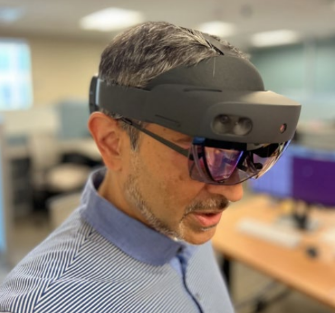Arlington, VA
Our Engineering, Test and Evaluation Division (ETED) is proud to announce the completion of an internal research and development effort to demonstrate the ability of Augmented Reality (AR) applications to leverage the ultra-reliable low latency (URLLC) features of 5G technology over an Open Radio Access Network (ORAN). The team demonstrated how a field user equipped with an AR-headset received seamless low-latency, high-bandwidth interactive AR remote assistance over 5G from a remote PC user located anywhere in the world. Using commercial off-the-shelf hardware and the latest open source 5G RAN and Core software, VT-ARC configured a 5GNR SA network supporting the required throughput and low latency for continuous real-time interactive two-way video, holographic document sharing, and virtual holographic mark-up of the field user’s environment.
This testing demonstrated the potential of 5G to enable new use cases using both Augmented Reality (AR) and Virtual Reality (VR) which will have an impact to both the commercial sector, such as education, training, entertainment, public safety, health care, communication, manufacturing, and retail; as well as DoD applications, such as immersive training, remote medical treatment, assembly trainings, maintenance of military facilities, advanced flight and ground vehicles simulations, virtual prototypes and remote collaboration on sensitive missions from anywhere in the world.
The VT-ARC team plans to expand this testing to demonstrate greater performance in support of additional use cases and mission scenarios. Additionally, VT-ARC conducts test and evaluation (T&E) of ORAN components utilizing their 5G ORAN Testbed. If you are interested in VT-ARC supporting your ORAN related T&E activities, please reach out to us for more information.




Comments are closed